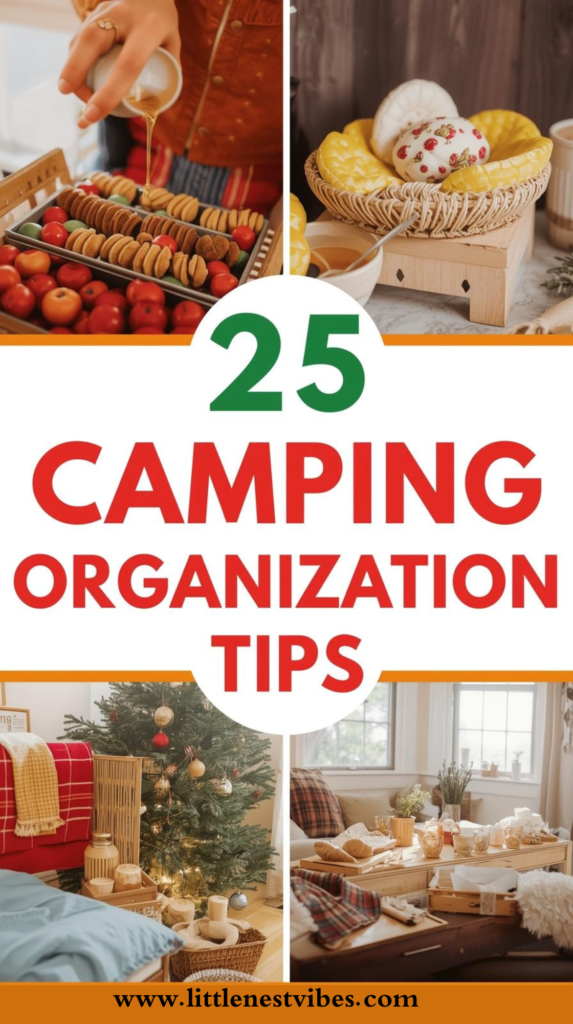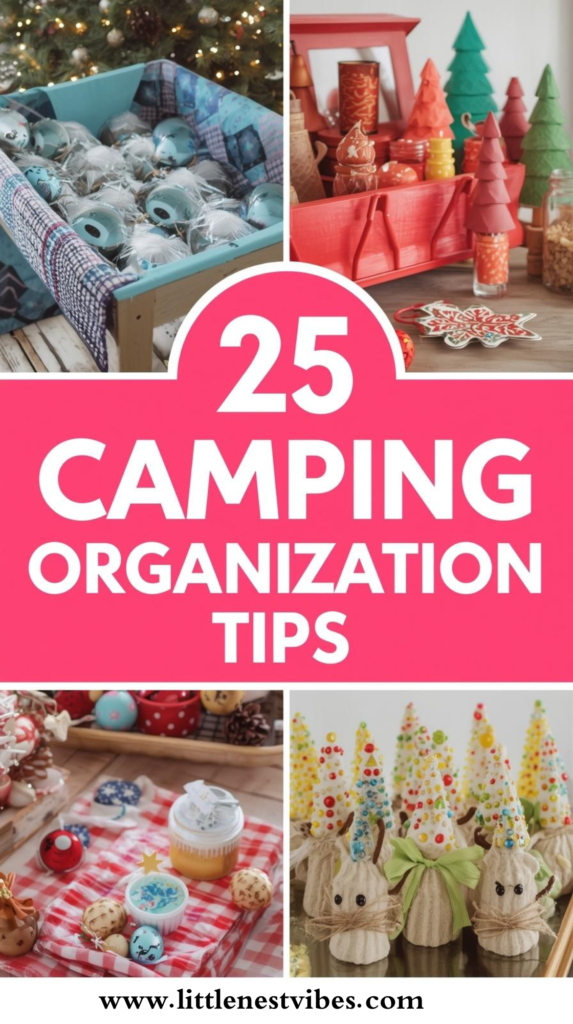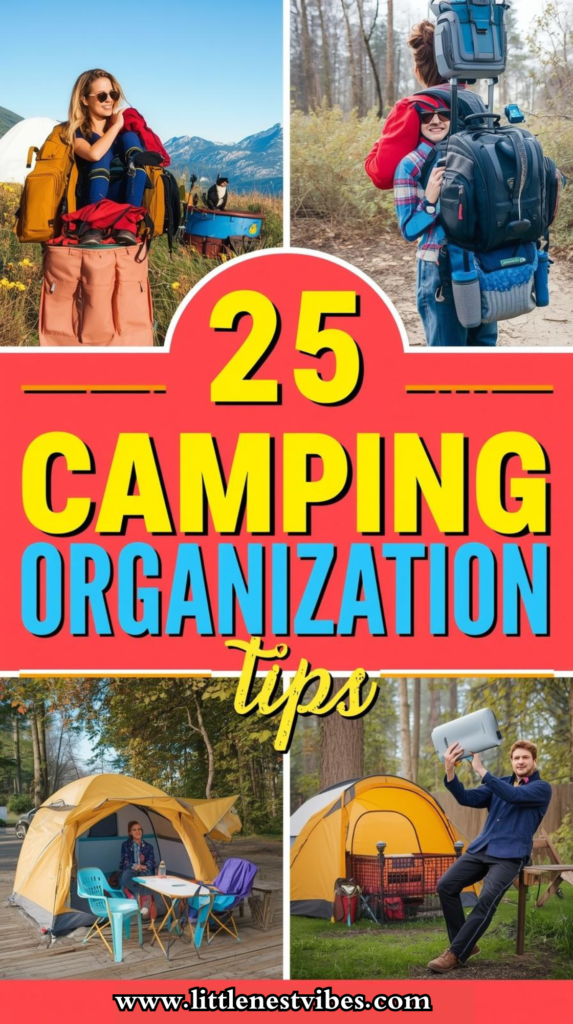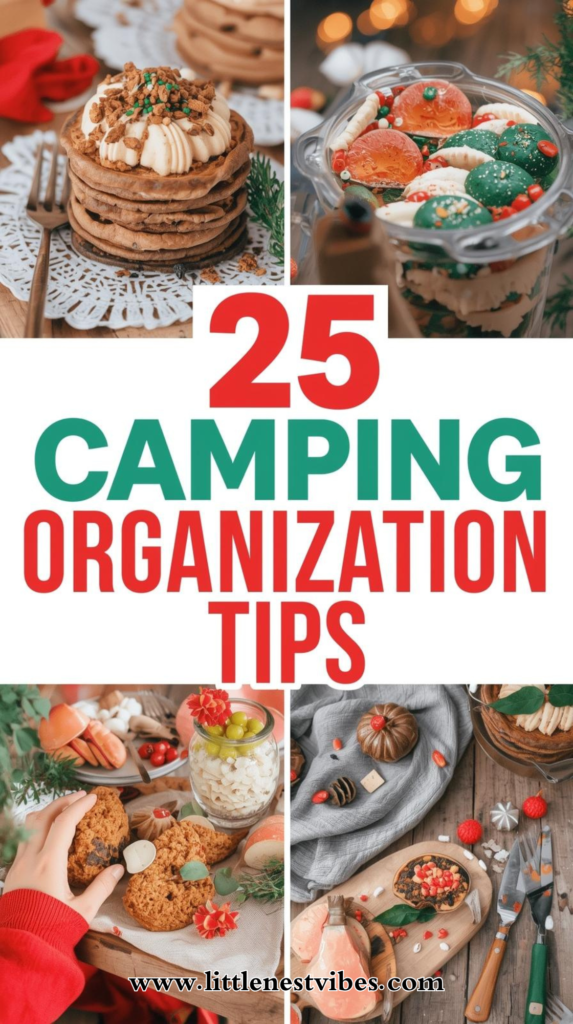Are you tired of tangled tent poles, misplaced gear, and the frustrating hunt for a flashlight in the dark?
You’re not alone. I’ve been there, too.
A few years ago, a surprise rainstorm caught me mid-setup, and I spent what felt like an eternity fumbling with gear, soaking wet and utterly miserable.
That moment was my wake-up call. I realized that the secret to a great camping trip isn’t just about the right gear—it’s about being organized.
For many, camping is the ultimate escape, a chance to disconnect and reconnect with nature.
But if your campsite feels more like a disaster zone than a peaceful retreat, you’re missing out.
This comprehensive guide, “25 Expert Camping Organization Tips,” is your roadmap to transforming your outdoor experiences. We’ll cover everything from smart packing to campsite setup, kitchen hacks, and long-term gear maintenance.
By the end, you’ll have a system so smooth, your friends will wonder if you hired a professional.
Think of this as a conversation around the campfire—I’ll share tried-and-true strategies that have saved me from countless headaches.
꧁*。゚Pin to Later *。゚꧂
Part 1: Pack Like a Pro—The Foundation of Camping Organization
The key to a smooth camping trip starts long before you even hit the road. It begins with intelligent, intentional packing. By using a systematic approach, you can avoid the pre-trip scramble and ensure you have everything you need, precisely where you need it.
1. The Ultimate Camping Gear Checklist
A camping gear checklist is your most important tool.
Before you pack a single item, create a master list.
This isn’t just a list of things to bring; it’s your blueprint for the trip.
Categorize items by type (e.g., shelter, cooking, clothing, first aid).
You can use a digital app like GearList or simply a pen and paper.
I prefer the latter—it’s a simple, reliable method that doesn’t require a battery.
A comprehensive checklist prevents you from forgetting essential items like your water filter or headlamp batteries.
2. The Power of Color-Coded Bags
To a new camper, a duffel bag of random gear looks like a chaotic mess.
The solution? Color-coded bags.
Use different colored bags or clear plastic bins with colored labels for each category of gear.
For example, a red bag for cooking supplies, a blue bag for clothes, and a green bag for tent and shelter items. This visual system is incredibly efficient.
This is a game-changer for family camping trips, where multiple people need to access different items quickly.
3. Roll Your Clothes, Don’t Fold Them
This is a classic space-saving hack.
Rolling your clothes not only saves a surprising amount of room in your pack but also helps prevent wrinkles. I’ve perfected a method where I roll socks and underwear inside larger clothing items like shirts and pants.
This simple technique can free up significant space, allowing you to carry a smaller pack or bring an extra layer for chilly nights.
4. Pack by Activity or Trip Phase
Instead of packing by item type, consider packing by how you’ll use the items.
This is often called activity-based packing.
For a backpacking trip, you might have one bag for all the gear you’ll need for the first night’s camp, another for a day hike, and so on. For car camping, this means packing a “kitchen box,” a “sleeping box,” and a “camp activities box.”
This prevents the common scenario of flipping your entire pack upside down at dusk, frantically searching for your headlamp.
5. Prioritize and Weigh Your Gear
Before every trip, I lay out all my gear and make a hard call on what to leave behind.
A simple kitchen scale is a great investment.
For backpackers, every ounce counts. Do you really need that cast-iron skillet? Could a lighter cooking pot and a simple multi-tool replace it?
I once replaced a bulky lantern with a compact, powerful headlamp and a few solar-powered string lights. The result? A lighter load and a more pleasant hiking experience.
By prioritizing essentials, you create a more efficient and enjoyable trip.
Part 2: Smart Gear Storage Solutions
Once you’ve packed, the next challenge is storing your gear at the campsite in a way that’s accessible and protected from the elements.
A well-organized storage system can make your tent feel like a home, not a cluttered cave. These solutions are born from years of trial and error in the field.
6. Invest in Modular Organizers
For car campers, modular storage bins are a lifesaver.
Hard plastic bins with lids stack neatly in your car, protecting your gear from dust, moisture, and pests.
I’ve used IKEA Samla boxes for years because they’re affordable, tough, and the perfect size.
Unlike duffel bags, they maintain their shape and don’t spill their contents when you move them.
꧁*。゚Pin to Later *。゚꧂
7. The Versatility of Carabiner Clips
Carabiner clips aren’t just for climbing. They are one of the most versatile camping accessories you can own.
Use them to clip keys, water bottles, or a GPS to the outside of your pack for quick access. Inside your tent, you can clip them to gear loops to hang lanterns or a gear loft.
8. Use Compression Sacks for Bulky Items
Your sleeping bag and puffy jacket take up the most space. Compression sacks are a must-have for shrinking these bulky items.
They use straps to compress the air out, reducing the volume by 20-30% or more.
This is essential for backpacking where every cubic inch matters. Many compression sacks are also waterproof, which is a bonus for protecting your sleeping bag from unexpected rain.
9. Label Everything with Sharpie and Tape
This might seem obvious, but it’s a tip many campers skip.
Labeling your bags and bins with a permanent marker on masking tape is a fast and easy way to identify contents at a glance. I even use simple icons—a flame for fire-starting gear, a utensil for cooking, and a tent for shelter.
This is particularly helpful for shared gear, making it easy for anyone to find what they need without asking you first.
10. Dry Bags for Wet Zones
Separating wet and dry gear is crucial for hygiene and comfort.
Use dry bags to store dirty, wet clothes and towels. This prevents moisture and odors from spreading to the rest of your gear.
After a rainy day hike, I use a dry bag to keep my wet socks and shoes separate from my sleeping clothes.
This simple act can prevent mold and mildew from forming on your gear, which is a surefire way to ruin a trip and a major camping mistake to avoid.
Part 3: Campsite Setup Mastery
Setting up camp should be a relaxing process, not a wrestling match.
With a little foresight and a few key strategies, you can turn a chaotic scene into an organized, efficient basecamp. A well-designed campsite enhances your comfort and makes daily routines a breeze.
11. Stake Out Your Layout First
Before you even start unpacking, take a moment to assess your campsite.
Identify the ideal spots for your tent, fire pit, and kitchen area. Consider factors like wind direction (so smoke doesn’t blow into your tent), drainage (to avoid a puddle under your sleeping bag if it rains), and proximity to water sources or trails.
By creating a mental or quick physical map, you prevent a lot of frustrating repositioning later. This camping organization tip is about creating a logical flow for your camp.
12. Use a Tarp as a Tent Base
Laying a durable tarp under your tent is one of the easiest ways to protect your gear.
It creates a clean, dry surface for unpacking and helps prevent moisture from seeping into the tent floor.
A good tarp also acts as a barrier, protecting the tent’s bottom from sharp rocks and sticks, significantly extending its lifespan.
13. String Up a Paracord Clothesline
Bring a length of paracord and a few carabiners or clips.
You can easily string this between two trees to create an impromptu clothesline.
This is perfect for drying wet towels, rain gear, or a fresh pair of socks. There’s nothing worse than putting on damp socks in the morning, and this simple trick ensures everything is dry and ready for the next day’s adventure.
14. Designate a “Dirty Zone”
Establish a specific area just outside your tent for muddy boots, wet gear, and anything you don’t want inside your sleeping space.
I use a small, inexpensive doormat for this purpose.
This simple camping hack keeps dirt and debris from being tracked into your tent, helping to maintain a clean and comfortable living space. A clean tent is a happy tent!
15. Light It Up Strategically
Good lighting is essential for nighttime camp life.
Don’t just rely on a single lantern. Use a combination of headlamps, hanging lanterns, and string lights.
Hang a larger lantern in a central area, like the cooking zone.
Use string lights around your tent or dining area for ambient light. Position a small, dim light inside your tent for easy visibility without a harsh glare.
Consider solar-powered lights that charge during the day—they are an energy-efficient and low-maintenance option.
꧁*。゚Pin to Later *。゚꧂
Part 4: Kitchen and Food Organization Hacks
Food is a highlight of any camping trip, but a disorganized kitchen can lead to frustration and unwanted animal visitors. These tips will help you streamline your meal prep, keep food fresh, and manage waste effectively.
16. Secure Your Pantry with Airtight Containers
Prevent spills and keep critters out by storing all food in airtight containers.
For backpacking, Ursack bags are a great lightweight option for bear-prone areas.
For car camping, dedicated plastic bins work perfectly.
Always store food securely in your vehicle or a bear canister at night. Never leave food unattended, as even a small crumb can attract a curious raccoon or bear.
17. Prep Your Meals in Advance
Save time and effort at the campsite by doing as much meal prep as possible at home.
Chop vegetables, portion out ingredients for specific meals, and pre-mix dry ingredients for pancakes or oatmeal. Label Ziploc bags by meal or day.
This significantly reduces waste, cleanup time, and the need for a full mobile kitchen. You can spend less time cooking and more time relaxing.
18. Use Collapsible Kitchen Gear
Space is always at a premium.
Invest in collapsible kitchen gear like sinks, bowls, cutting boards, and water carriers. They pack down to a fraction of their size and can be nested inside each other.
This is a smart way to bring everything you need for a comfortable cooking experience without the bulky footprint.
19. Smart Spice Storage
Instead of bringing bulky jars of spices, use a pill organizer or small, travel-sized containers to bring just what you need.
A tiny, well-organized spice kit can add a huge amount of flavor to your camp meals without adding a lot of weight or taking up space. It’s a tiny hack that makes a huge difference.
20. Implement a Trash Management System
A dedicated trash system is essential.
Bring multiple sturdy garbage bags and a small, collapsible bin.
Designate one for general trash, one for recyclables, and one for food waste.
Tie off your trash bags tightly and hang them from a tree branch (away from camp) or store them securely in your vehicle at night. This prevents animals from getting into your food waste and keeps your campsite clean for you and future campers.
Part 5: Daily Routines and Long-Term Tips
Organization isn’t just about what you do once. It’s about establishing habits that make every trip better. These tips focus on the daily routines and long-term planning that will sustain your organized camping style for years to come.
21. Morning Gear Check
Make a habit of a quick 5-10 minute gear sweep each morning.
Pack up any items you used for breakfast or the previous night. Fold up sleeping bags and put them away.
This prevents a slow build-up of clutter throughout the day. You’ll thank yourself when you come back from a hike to a tidy campsite.
22. Journal Your Inventory
Keep a simple camping journal or a note on your phone.
After each trip, jot down what worked, what you didn’t use, and what you wished you had.
Did you forget a can opener? Was that camp chair too bulky? Use these notes to refine your gear list for the next trip.
This is how you evolve from a novice camper to an expert camping organizer.
23. Assign Family Roles
If you’re camping with a group or family, assign specific roles.
One person handles the cooking, another manages the fire, and the kids can be in charge of setting up their sleeping bags. This shared responsibility not only lightens the load but also makes everyone feel like a part of the team.
24. Utilize Hybrid Tech for Tracking
Use digital apps like Campendium for site reviews and weather forecasts, but don’t forget the value of a physical logbook.
Jot down details about specific campsites you liked, notes on the best trails, or which gear performed well.
25. The Post-Trip Unpack Ritual
The final, and perhaps most important, step in camping organization is the post-trip ritual.
As soon as you get home, unload your car. Air out your tent and sleeping bags to prevent mildew.
Wipe down gear and repack it neatly. Putting everything away immediately ensures it’s ready for your next adventure and prevents that musty smell that can ruin expensive gear.
Conclusion: Your Adventure, Uncluttered
You’ve now got a comprehensive toolkit of 25 expert camping organization tips.
From mastering your packing list to setting up an efficient campsite and maintaining your gear long-term, these strategies are designed to eliminate the frustrations that often come with camping.
The goal isn’t just to have a tidy campsite.
It’s to free up your mental energy so you can focus on what truly matters: the sound of a crackling fire, the tranquility of a starlit sky, and the joy of shared stories.
Pick a few of these tips and implement them on your next outing.
Even small changes can make a huge difference.
Now that you’re armed with these ideas, what’s one thing you’re going to change about your camping routine? Tell us in the comments!
Happy camping, and may your adventures be forever organized and stress-free.
꧁*。゚Pin to Later *。゚꧂











